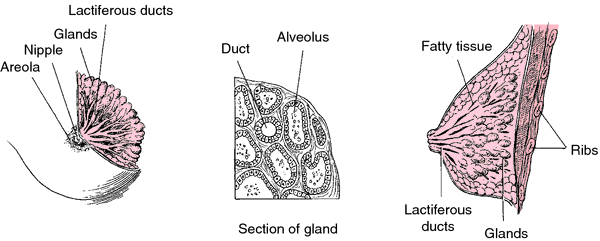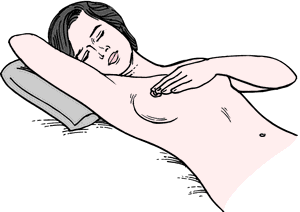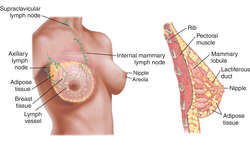breast
[brest] the front of the chest, especially the modified cutaneous, glandular structure it bears, the mamma. In women the breasts are secondary sex organs with the function of producing milk after childbirth. The term breast is less commonly used to refer to the breasts of the human male, which neither function nor develop.
At the tip of each breast is an area called the areola, usually reddish in color; at the center of this area is the
nipple. About 20 separate lactiferous ducts empty into a depression at the top of the nipple. Each duct leads from alveoli within the breast called lobules, where the milk is secreted. Along their length, the ducts have widened areas that form reservoirs in which milk can be stored. The ducts and lobules form the glandular tissue of the breasts. Connective tissue covers the glandular tissue and is itself sheathed in a layer of fatty tissue. The fatty tissue gives the breast its smooth outline and contributes to its size and firmness.

Breast, with detail and cross section.

Breast self-examination. From Lowdermilk et at., 2000. 1. The best time to do breast self-examination is after your period, when breasts are not tender or swollen. If you do not have regular periods or sometimes skip a month, do it on the same day every month. 2. Lie down and put a pillow under your right shoulder. Place your right arm behind your head (Fig. 1). 3. Use the finger pads of your three middle fingers on your left hand to feel for lumps or thickening. Your finger pads are the top third of each finger. 4. Press firmly enough to know how your breast feels. If you're not sure how hard to press, ask your health care provider, or try to copy the way your health care provider uses the finger pads during a breast examination. Learn what your breast feels like most of the time. A firm ridge in the lower curve of each breast is normal. 5. Move around the breast in a set way. You can choose either circles (Fig. 2, A), vertical lines (Fig. 2, B), or wedges (Fig. 2, C€). Do it the same way every time. It will help you to make sure that you've gone over the entire breast area and to remember how your breast feels. 6. Gently compress the nipple between your thumb and forefinger and look for discharge. 7. Now examine your left breast using the finger pads of your right hand. 8. If you find any changes, see your health care provider right away. 9. You may want to check your breasts while standing in front of a mirror right after you do your breast self-examination each month. See if there are any changes in the way your breasts look: dimpling of the skin, changes in the nipple, or redness or swelling. 10. You may also want to do an extra breast self-examination while you're in the shower (Fig. 3). Your soapy hands will glide over the wet skin, making it easy to check how your breasts feel. 11. It is important to check the area between the breast and the underarm and the underarm itself. Also examine the area above the breast to the collarbone and to the shoulder.
Surgery of the Breast. Surgical operations of the breast are done for a variety of reasons. mammoplasty refers to reconstructive surgery of the breast and includes procedures to enlarge the breasts (augmentation mammoplasty), reduce their size (reduction mammoplasty), or reconstruct one or both breasts so that they are equal in size and contour. With the advent of less radical surgery for breast malignancies, postmastectomy plastic surgery of the breast has become more commonplace. mastectomy is surgical removal of breast tissue; it is most often done to treat breast cancer. Procedures can vary from a simple lumpectomy to a radical procedure in which the surgeon removes the internal mammary chain of lymph nodes, the entire breast, the underlying pectoral muscles, and the adjacent axillary lymph nodes.
breast cancer malignancy of the breast; it is second only to lung cancer as a cause of cancer deaths in North American women. It currently affects 1 in 9 women in the United States (11 per cent) and is called an epidemic by authorities. The incidence of breast cancer appears to be rising each year, even though when all age groups are considered its death rate has slightly declined in the past two decades. Risk factors include age over 40, close family member with breast cancer, onset of menses before age 13 or continuation beyond age 50, nulliparity, and first child after age 30.
Breast Self-Examination. Women should train themselves to perform a simple self-examination of the breasts (see illustration). The best time for this is just after menstruation when the breasts are normally soft. If any lump in the breast can be felt, a health care provider should be consulted immediately.
As with other forms of cancer, early detection and prompt treatment of malignancy of the breast are the keys to eradication of the disease. Studies have shown that breast self-examination has contributed to earlier detection and improved survival rates. It should be done monthly; more than 90 percent of breast cancers are discovered by the patients themselves either by chance or by routine self-examination. The American Cancer Society reports that only about 69 percent of women polled in the past had done self-examination at any time during the past year and less than 29 percent did it routinely each month.
Screening should begin by age 40 and should consist of a clinical examination every year and screening mammography every one or two years. Beginning at age 50, both the clinical examination and the mammography should be done once a year. mammography is considered to be the best diagnostic method for early detection when tumors are small and not readily found by palpation. Other diagnostic techniques include thermography, ultrasonography, magnetic resonance imaging, and computerized tomography, but none of these is believed to be as accurate as mammography. The first symptom noted is usually a lump or nodule in the breast tissue; however, dimpling of the breast skin or changes in the nipple may be noted before a lump is found. Diagnosis of a malignant tumor is confirmed by biopsy.
Treatment. Options for treatment of breast cancer are based on the clinical stage of the disease when first diagnosed or when re-evaluated. Formerly, the most common procedure was radical mastectomy. However, improvements in irradiation equipment and procedures, alternative surgical techniques that are less mutilating, and more active participation of patients in making decisions about the mode of therapy have all resulted in significant changes in the treatment of breast cancer.
Additional information can be obtained by calling the National Cancer Institute's Cancer Information Service Hotline at 1-800-4-CANCER.
chicken breast pectus carinatum.
funnel breast pectus excavatum.
pigeon breast pectus carinatum.
Miller-Keane Encyclopedia and Dictionary of Medicine, Nursing, and Allied Health, Seventh Edition. © 2003 by Saunders, an imprint of Elsevier, Inc. All rights reserved.
breast
(brest), [TA] 1. The pectoral surface of the thorax.
2. The female organ of milk secretion; one of two commonly hemispheric projections anterior to the pectoral muscles including the mammary glands within a highly variable amount of fat in the subcutaneous tissue and bearing the nipple superficially on either side of the chest of the mature female; it is rudimentary in the male.
Synonym(s): mamma [TA], teat (2)
[A.S. breōst]
Farlex Partner Medical Dictionary © Farlex 2012
breast
(brĕst)n.1. Either of two milk-secreting, glandular organs on the chest of a woman.
2. A corresponding rudimentary gland in a human male, especially when enlarged by exposure to estrogen or appearing to be enlarged by overlying body fat.
3. The superior ventral surface of the human body, extending from the neck to the abdomen.
4. A corresponding part in other animals.
The American Heritage® Medical Dictionary Copyright © 2007, 2004 by Houghton Mifflin Company. Published by Houghton Mifflin Company. All rights reserved.
breast
(brest) 1. The pectoral surface of the thorax.
2. The organ of milk secretion; one of two hemispheric projections situated in the subcutaneous tissue anterior to the pectoralis major muscle on either side of the thorax or chest of the mature female; it is rudimentary in the male.
Synonym(s): mamma [TA] , teat (2) .
[A.S. breōst]
Medical Dictionary for the Health Professions and Nursing © Farlex 2012
breast
(brest) 1. The upper anterior aspect of the chest.


BREAST: Structure of mammary glands
2. The mammary gland, a compound alveolar gland consisting of 15 to 20 lobes of glandular tissue separated from each other by interlobular septa. Each lobe is drained by a lactiferous duct that opens onto the tip of the nipple. The mammary gland secretes milk used for nourishment of the infant. For purposes of description, the female breast is divided into four quadrants: upper inner (the top medial quarter), lower inner (the bottom medial quarter), upper outer (the top lateral quarter), and the lower outer (the bottom lateral quarter). The tail of the breast extends up and away from the upper outer quadrant. See:
illustration; mammary gland; milk
Development
During puberty, estrogens from the ovary stimulate growth and development of the duct system. During pregnancy, progesterone secreted by the corpus luteum and placenta acts synergistically with estrogens to bring the alveoli to complete development. After parturition, prolactin in conjunction with adrenal steroids initiates lactation, and oxytocin from the posterior pituitary induces ejection of milk. Sucking or milking reflexly stimulates both milk secretion and discharge of milk.
Changes in Pregnancy
During the first 6 to 12 weeks, there is fullness and tenderness, erectile tissue develops in the nipples, nodules are felt, pigment is deposited around the nipple (primary areola) (in blondes the areolae and nipples become darker pink; in brunettes they become dark brown and sometimes even black), and a few drops of fluid may be squeezed out. During the next 16 to 20 weeks, the secondary areola shows small whitish spots in pigmentation due to hypertrophy of the sebaceous glands (glands of Montgomery).
caked breast
An accumulation of milk in the secretory ducts of the breast after delivery, causing a large area to become inflamed, hard, and tender.
chicken breast
A deformity in which the sternum projects anteriorly; caused by rickets or obstructed respiration in childhood. Synonym: pigeon breast
pigeon breast
Chicken breast.illustrationillustrationMedical Dictionary, © 2009 Farlex and Partners
Patient discussion about breast
Q. how to avoid breast cancer? i heard that wearing bras when sleeping causes breast cancer and i've been doing this for the past 2 years and now i'm so scared
A. I'm not sure how to avoid it but I can tell you for sure that going to check yourself every year is extremely important and has helped save so many lives. you can never be too carefull...
Q. Is there any possibility for me to have breast cancer? I am having a lot of pain in my right breast, close to chest and underarm. I’m 24 year old female. I have large breasts, but I do not feel any lumps. Is there any possibility for me to have breast cancer? Thank you very much.
A. at the age of 24 breast cancer is extremely rare, not that it's never heard of, but it's rare. if you feel no lumps it's even more unlikely.
but just for the chance that it is and even if it's not cancer but something else- go get checked.
Q. what is inflamatory breast cancer?
A. It's a type of breast cancer that presents as an indurated, or hardened, red and edematous skin over the breast. It's considered an advanced cancer, and in most times when it's diagnosed there are cancer cells in the lymph nodes in the armpit (axilla) or metastases elsewhere in the body. It may be mistaken with infection of the breast.
You can read more here: http://en.wikipedia.org/wiki/Inflammatory_breast_cancer
More discussions about breastThis content is provided by iMedix and is subject to iMedix Terms. The Questions and Answers are not endorsed or recommended and are made available by patients, not doctors.


